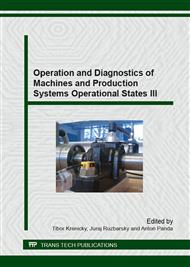[1]
E.J. Vinarcik, High Integrity Die Casting Processes, John Wiley and Sons, New York, (2003).
Google Scholar
[2]
S. Gaspar, J. Pasko, Metal flow velocity in an intake port in the process of die casting, Advanced Materials research 705 (2013) 177-180.
DOI: 10.4028/www.scientific.net/amr.705.177
Google Scholar
[3]
S. Gaspar, J. Pasko, Influence of technological factors of die casting on mechanical properties of castings from silumin, Lecture Notes in Electrical Engineering 240 (2013) 713-722.
DOI: 10.1007/978-94-007-6738-6_88
Google Scholar
[4]
J. Ruzbarsky, J. Zarnovsky, Optimization of parameters in the compression moulding process of thermoset products, Advanced Materials Research 801 (2013) 61-66.
DOI: 10.4028/www.scientific.net/amr.801.61
Google Scholar
[5]
Ľ. Bičejová, Abrasive kind and granularity changes affects to water jet technology head vibration during cutting HARDOX material thickness alternation process, Applied Mechanics and Materials 308 (2013) 75-79.
DOI: 10.4028/www.scientific.net/amm.308.75
Google Scholar
[6]
Ľ. Bičejová, Water jet technology head vibration generation due to selected technology parameters fluctuation effect during alloy cutting, Applied Mechanics and Materials 308 (2013) 81-86.
DOI: 10.4028/www.scientific.net/amm.308.81
Google Scholar
[7]
E. Tillova, M. Chalupova, R. Konecna, Structural study of silumin AlSi7MgTi, Acta Metallurgica Slovaca 7 (2001) 456-458.
Google Scholar
[8]
L. Stailcek, A.I. Batysev, L. Caplovic, K.A. Batysov, Metallographic verification of the model of the flow enforced during solidification under high external pressure, Die Cast Eng. 51 (2007) 56-60.
Google Scholar
[9]
P. Bigos, M. Puskar, L. Pesek, Assessment of the critical places in the casted piston based on a local strength – microstructure model, Chemical Letters 106/S3 (2012) 379-382.
Google Scholar
[10]
E. Ragan et al., Die casting, VMV Prešov, (2007).
Google Scholar
[11]
R. Ravikumar, K.S. Amirthagadeswaran, P. Senthil, Parametric Optimization of Squeeze Cast AC2A-Ni Coated Composite Using Taguchi Technique, Advances in Materials Science and Engineering 2014 (2014) 1–10.
DOI: 10.1155/2014/160519
Google Scholar
[12]
M. Rimar, M. Fedak, J. Mihalcova, Adaptive Rejecton Filter for the Drivers Stabilization of Pressure Die Casting Machines, Advances in Mechanical Engineering (2014) Article ID 453724.
DOI: 10.1155/2014/453724
Google Scholar
[13]
R. Monroe, Porosity in castings, AFS Transactions, USA, 2005, 519-546.
Google Scholar


